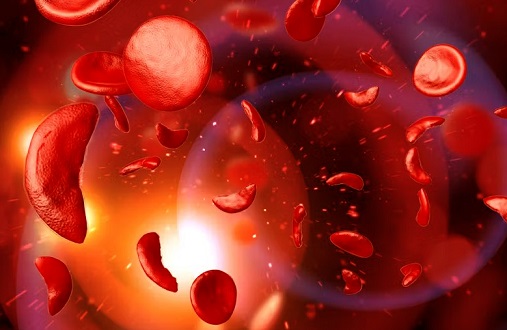Nikhil Prasad Fact checked by:Thailand Medical News Team Nov 19, 2024 5 months, 6 days, 22 hours, 31 minutes ago
Medical News: Long COVID, a condition where symptoms persist for weeks or months after the acute phase of COVID-19, continues to baffle scientists worldwide. While most discussions focus on fatigue, brain fog, or breathlessness, new research highlights something unexpected - changes in the very cells that carry oxygen throughout our bodies.
 Long COVID and the Hidden Changes in Red Blood Cells
Long COVID and the Hidden Changes in Red Blood Cells
This
Medical News report dives into a groundbreaking study led by researchers from the German Sport University Cologne and the S.P.O.R.T. Institut in Overath, Germany, to uncover how red blood cell (RBC) abnormalities might play a role in Long COVID’s lingering effects.
What the Study Looked At
The research examined blood samples from 30 individuals with Long COVID and compared them to 30 healthy controls. By analyzing the shape, flexibility, and behavior of RBCs, the study aimed to identify potential differences that could explain some of Long COVID’s most stubborn symptoms, such as fatigue.
To ensure comprehensive results, the team used advanced tools like the laser-assisted optical rotational red cell analyzer. The study not only explored RBC deformability but also evaluated their aggregation - the tendency of cells to clump together. The researchers assessed the cells’ “mechanical sensitivity index,” which indicates their ability to deform under stress, a critical factor for efficient blood flow.
Key Findings: Abnormalities in Blood Cells
The study revealed striking differences between the blood of Long COVID patients and healthy controls:
-Morphological Abnormalities
Long COVID patients exhibited nearly 21% abnormally shaped RBCs, compared to just 3% in controls.
These abnormalities included shapes like echinocytes (spiky cells) and dacrocytes (tear-shaped cells), which may struggle to navigate through tiny capillaries.
-Increased Aggregation
RBCs in Long COVID patients had a higher tendency to clump together. This could slow down blood flow, reducing oxygen delivery to tissues.
-Deformability vs. Functionality
While the deformability of RBCs was slightly improved in Long COVID patients, their ability to return to normal shape after stress - measured as the mechanical sensitivity index - was significantly impaired.
This reduced resilience could mean that RBCs in Long COVID patients have a shorter lifespan, potentially leading to chronic inefficiencies in oxygen transport.
Fatigue and Its Connection to Blood Cell Changes
Fatigue, one of the hallmark symptoms of Long COVID, seems closely linked to these RBC changes. The study found a clear correlation between the extent of RBC abnormalities and the severity of fatigue.
The more pronounced the cellular damage, the worse the fatig
ue reported by patients. This connection underscores the possibility that impaired oxygen delivery caused by abnormal RBCs might be driving this debilitating symptom.
Implications for Future Research and Treatment
The findings point to the need for further research into how SARS-CoV-2, the virus behind COVID-19, impacts blood cells. Persistent abnormalities in RBCs, even months after infection, suggest long-lasting effects on the circulatory system.
Therapies aimed at improving RBC health, such as specific exercise programs or treatments targeting blood flow dynamics, could offer relief for Long COVID sufferers. Understanding the root causes of these cellular changes might also pave the way for novel interventions.
Conclusion: Why This Matters
This study sheds new light on the physical underpinnings of Long COVID, emphasizing that the condition extends far beyond its visible symptoms. The abnormal behavior of RBCs - key players in oxygen transport - offers a tangible explanation for some of Long COVID’s lingering effects.
While the precise mechanisms remain unclear, the research marks an important step toward understanding this complex syndrome. It also highlights the need for tailored approaches to help patients regain their quality of life.
The study findings were published in the peer-reviewed journal: Biology.
https://www.mdpi.com/2079-7737/13/11/948
For the latest Long COVID News, keep on logging to Thailand
Medical News.
Read Also:
https://www.thailandmedical.news/news/covid-19-causes-morphological-changes-of-red-blood-cells-leading-to-microangiopathy-microthrombosis-impaired-blood-flow-tissue-oxygenation
https://www.thailandmedical.news/news/covid-19-causes-deformation-of-red-blood-cells,-leading-to-anemia
https://www.thailandmedical.news/news/covid-19-news-sars-cov-2-impairs-oxygen-delivery-by-altering-red-blood-cell-hematological,-hemorheological-and-oxygen-transport-properties
https://www.thailandmedical.news/news/breaking-covid-19-news-sars-cov-2-affects-red-blood-cell-morphology
https://www.thailandmedical.news/news/breaking-news-german-and-swiss-researchers-discover-increased-red-blood-cell-deformation-in-children-and-adolescents-after-sars-cov-2-infection
https://www.thailandmedical.news/news/covid-19-news-study-shows-that-red-blood-cells-play-a-role-in-multi-organ-spread-of-sars-cov-2
https://www.thailandmedical.news/news/sars-cov-2-news-study-shows-that-release-of-immature-blood-cells-from-bone-marrow-signifies-covid-19-severity
https://www.thailandmedical.news/news/covid-19-latest-sars-cov-2-may-target-red-marrow-and-prevent-formation-of-new-erythrocytes--vitamin-b12-supplementation-important
https://www.thailandmedical.news/news/must-read-research-reveals-that-covid-19-attacks-hemoglobin-in-red-blood-cells,-rendering-it-incapable-of-transporting-oxygen--current-medical-protoco
